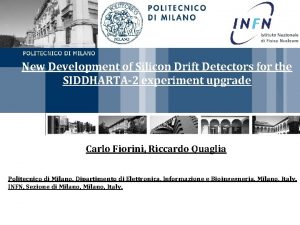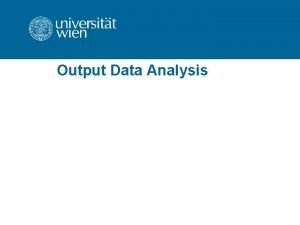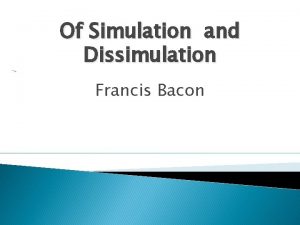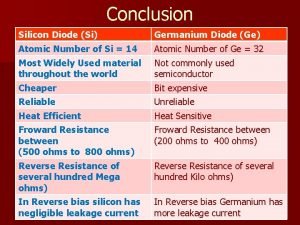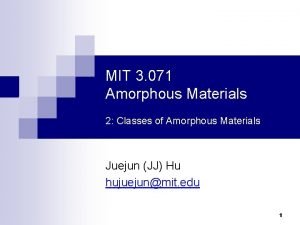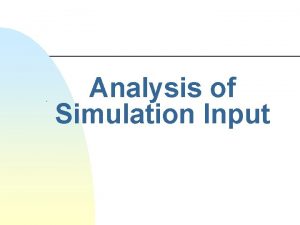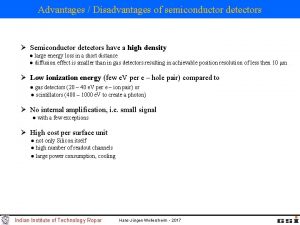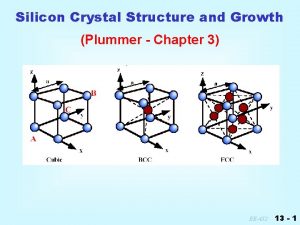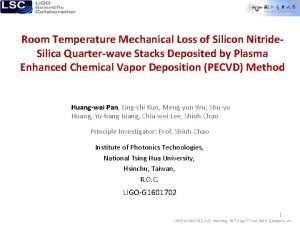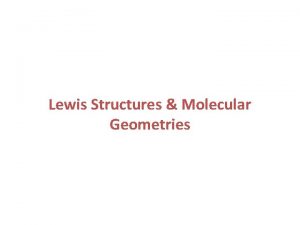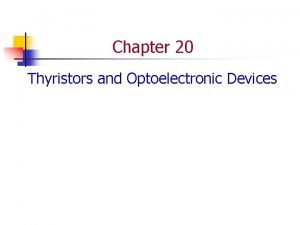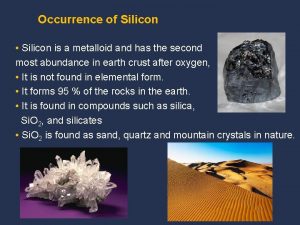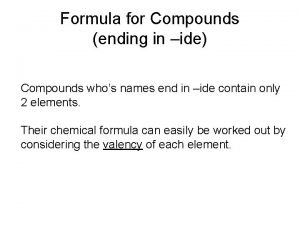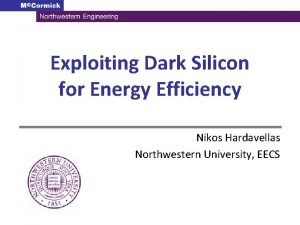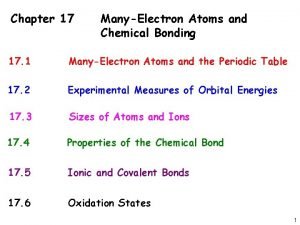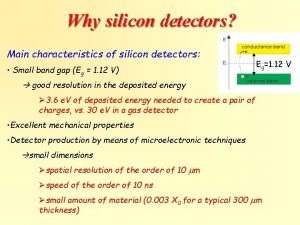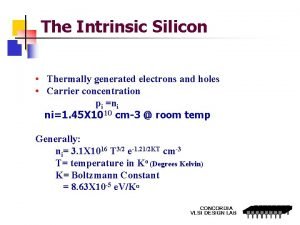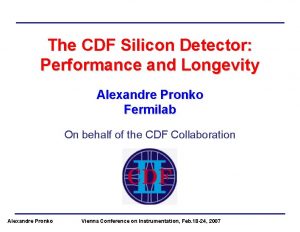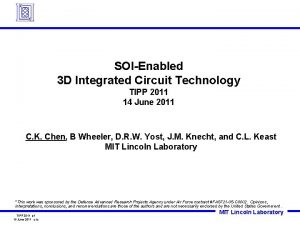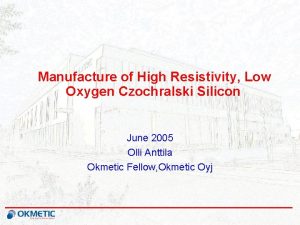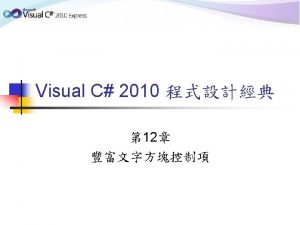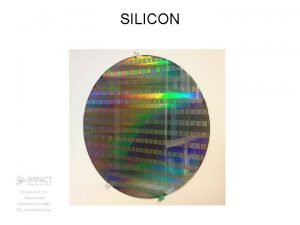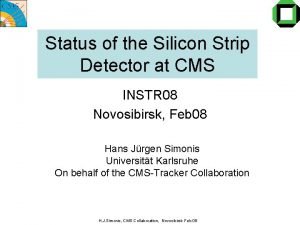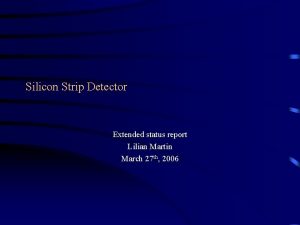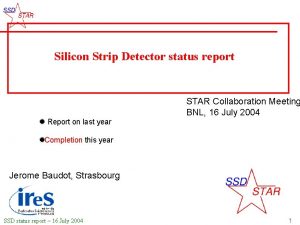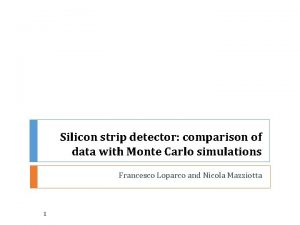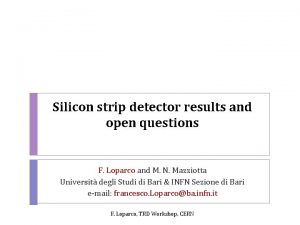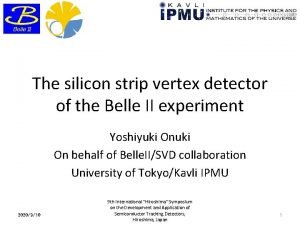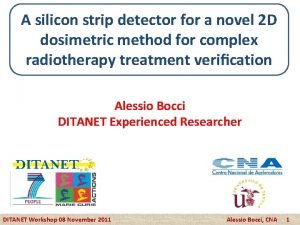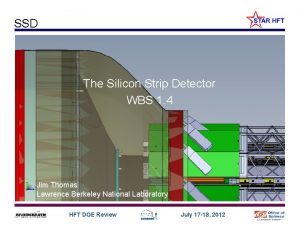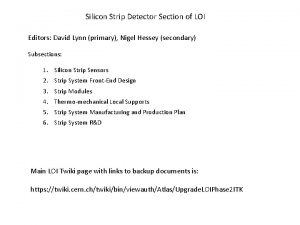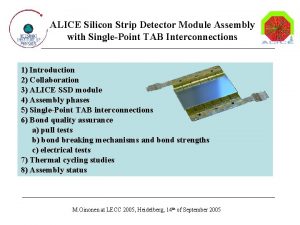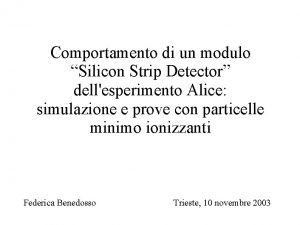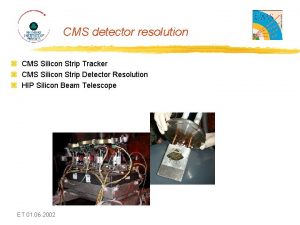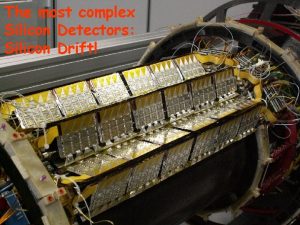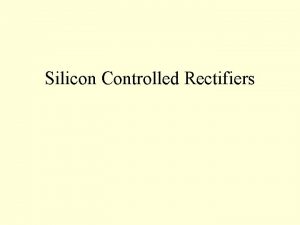Silicon strip detector data analysis and simulation status












































- Slides: 44

Silicon strip detector data analysis and simulation: status report Francesco Loparco and Nicola Mazziotta 1

Set-up and geometry Horizontal view – y axis (junction side) Vertical view – z axis (ohmic side) Beam He pipe Radiator 220 cm Si strip detector (thickness = 300µm) z y x 2

Pedestals and noise Ø All strips with a RMS > 3 ke. V have been masked o 5/384 masked strips in the horizontal view § All masked strips are at the edges of the detector o 13/384 masked strips in the vertical view § Some masked strips are in the central region of the detector Ø The RMS are almost uniform in both the horizontal and vertical views Ø Still a few noisy strips in the vertical view (to be masked? ) 3

Event selection � 4

Event classification � Class 1 events: One X-ray cluster in both horizontal and vertical views � Particle and X-ray energy taken from the horizontal view � These events are used to reconstruct the TR angular and energy spectrum � � Further event classes: � Events with the same number of X-ray clusters in both views � The matching could be done looking at energies of X-ray clusters � Events with different numbers of X-ray clusters in the two views � In one view the X-ray could have been absorbed in the same detector region crossed by the particle � Correct matchings might be not straightforward! 5

Detector simulation � Evaluation of the TR spectrum produced at the radiator � Evaluation of the spectrum of TR X-rays absorbed by the detector � Generation of the Monte Carlo event sample � Simulation of the detector response � Noise � Response to the particle � Response to X-rays � Implementation of the clustering algorithm and of the same event selection as in real data 6

TR spectrum produced at the radiator � 7

Spectrum of TR X-rays absorbed by the detector � 8

X-ray absorption lengths in the simulation 9

MC simulation workflow � 10

Detector simulation: noise � To each strip an energy is assigned extracted from a Gaussian PDF with null mean and RMS corresponding to the average RMS evaluated from a pedestal run Strips in the horizontal view: RMS = 1. 39 ke. V � Strips in the vertical view: RMS = 1. 77 ke. V � 11

Detector simulation: response to the particle � The particle energy is extracted from a Landau distribution peaked at 83. 5 ke. V (same value as in real data) � The particle energy is shared in a cluster of strips centered on the impact point of the particle on the detector The number of strips in the cluster is extracted from the strip multiplicity distribution of particle clusters in real data � A Gaussian profile centered on the particle position is assumed for the energy distribution among the strips in the cluster � 12

Detector simulation: response to X-rays � The energy of an X-ray is shared between the two strips which are closer to the X-ray position � The energy is shared taking into account the measured distributions A random value of is extracted from the distribution � A fraction of the X-ray energy is assigned to the left strip and a fraction 1 - is assigned to the right strip � 13

Some caveats � The simulation does not include the response of individual strips � All strips are assumed to have the same noise (RMS of 1. 39 ke. V for horizontal strips, 1. 77 ke. V for vertical ones) � The energy threshold for photon clusters is sharp (5. 6 ke. V in the horizontal view, 7. 1 ke. V in the vertical view) � The simulation does not include the real beam profile � The beam is assumed to have a circular cross section of 0. 5 cm radius 14

Data-MC comparison: mylar radiators � 15

Mylar radiator 1 set – 20 Ge. V/c electrons 16

Mylar radiator 1 set – 300 Ge. V/c muons 17

Mylar radiator 1 set – 180 Ge. V/c muons 18

Mylar radiator 1 set – 120 Ge. V/c muons 19

Mylar radiator 3 sets – 20 Ge. V/c electrons 20

Mylar radiator 3 sets – 300 Ge. V/c muons 21

Mylar radiator 3 sets – 180 Ge. V/c muons 22

Mylar radiator 3 sets – 120 Ge. V/c muons 23

Data-MC comparison: polyetylene radiators � 24

Polyetylene radiator 1 set – 300 Ge. V/c muons 25

Polyetylene radiator 3 sets – 20 Ge. V/c electrons 26

Polyetylene radiator 3 sets – 300 Ge. V/c muons 27

Polyetylene radiator 3 sets – 180 Ge. V/c muons 28

Polyetylene radiator 3 sets – 120 Ge. V/c muons 29

Data-MC comparison: polypropylene radiator with thin foils � 30

Polypropylene thin foils – 20 Ge. V/c electrons 31

Polypropylene thin foils – 300 Ge. V/c muons 32

Polypropylene thin foils – 180 Ge. V/c muons 33

Polypropylene thin foils – 120 Ge. V/c muons 34

Data-MC comparison: polypropylene radiator with thick foils � 35

Polypropylene thick foils – 20 Ge. V/c electrons 36

Polypropylene thick foils – 300 Ge. V/c muons 37

Polypropylene thick foils – 180 Ge. V/c muons 38

Polypropylene thick foils – 120 Ge. V/c muons 39

Data-MC comparison: fiber radiator � 40

Fiber radiator – 20 Ge. V/c electrons 41

Fiber radiator – 180 Ge. V/c muons 42

Fiber radiator – 120 Ge. V/c muons 43

Summary and ongoing work � We have implemented a MC simulation code including the TR generation, the photon propagation and the detector response � The simulation reproduces fairly well some experimental configurations � Discrepancies are found with some radiators � Further comparisons between simulation and data are ongoing � Possible improvements: � Simulation of the TR spectra from irregular radiators � Fine tuning of the detector simulation 44
 Silicon drift detector explained
Silicon drift detector explained Silicon drift detector principle
Silicon drift detector principle Status strip in vb.net
Status strip in vb.net Output data analysis in simulation
Output data analysis in simulation Simulation kelton
Simulation kelton Nisac
Nisac Of simulation and dissimulation text
Of simulation and dissimulation text Of simulation and dissimulation
Of simulation and dissimulation Simulation process and data management
Simulation process and data management Zener diode conclusion
Zener diode conclusion Amorphous
Amorphous Dot and cross diagram for water
Dot and cross diagram for water What is made up of silicon and aluminium
What is made up of silicon and aluminium What is made up of silicon and aluminium
What is made up of silicon and aluminium Data collection procedure and data analysis
Data collection procedure and data analysis Data preparation and basic data analysis
Data preparation and basic data analysis Data acquisition and data analysis
Data acquisition and data analysis Input analysis simulation
Input analysis simulation Simulation data collection
Simulation data collection Advantages of semiconductor detector
Advantages of semiconductor detector Silicon crystal lattice
Silicon crystal lattice Silicon at room temperature
Silicon at room temperature Quantum number of silicon
Quantum number of silicon Pirates of silicon valley sinopsis
Pirates of silicon valley sinopsis Abe notation
Abe notation Silicon valley dubai apartments
Silicon valley dubai apartments Captusire proteza cu silicon
Captusire proteza cu silicon Sus thyristor
Sus thyristor Neon bohrs model
Neon bohrs model Silicon valley of india
Silicon valley of india Silicon based life form
Silicon based life form Occurrence of silicon
Occurrence of silicon Lithium and nitrogen formula
Lithium and nitrogen formula Nikos hardalias
Nikos hardalias Covalent molecular and covalent network
Covalent molecular and covalent network N and l electron configuration
N and l electron configuration The story of silicon valley case study
The story of silicon valley case study Characteristics of silicon
Characteristics of silicon Intrinsic silicon
Intrinsic silicon Silicon magnet
Silicon magnet Silicon on insulator
Silicon on insulator Gaslog telemetry
Gaslog telemetry Cz silicon wafer with high resistivity
Cz silicon wafer with high resistivity Silicon graphics google earth
Silicon graphics google earth Silicon wafer back grinding
Silicon wafer back grinding
